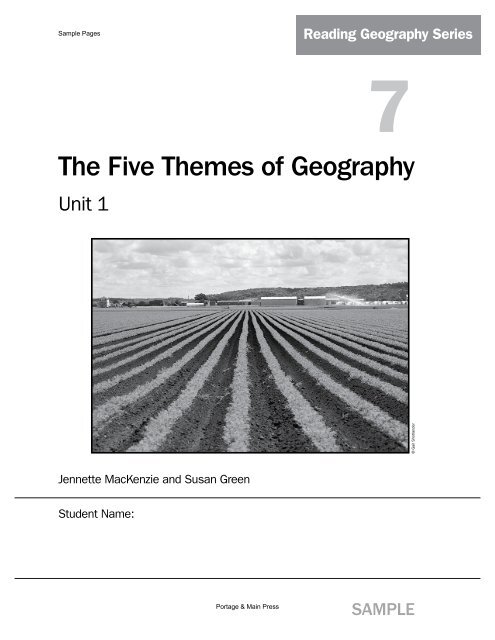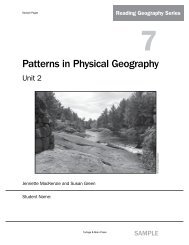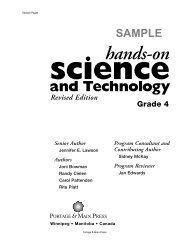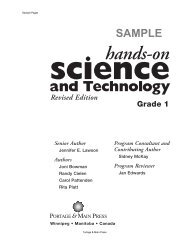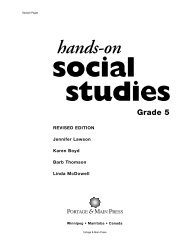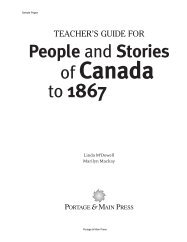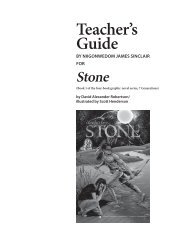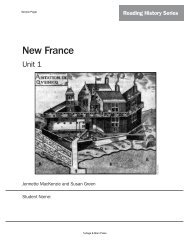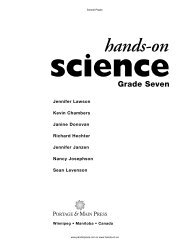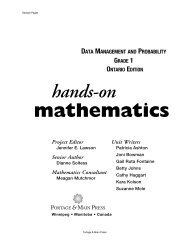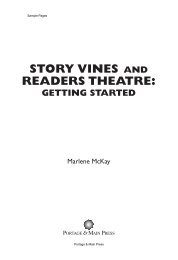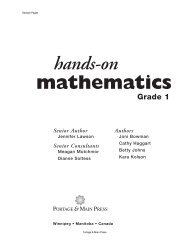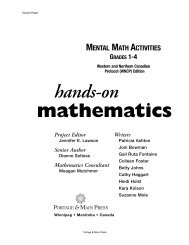The Five Themes of Geography (Unit 1) - Portage & Main Press
The Five Themes of Geography (Unit 1) - Portage & Main Press
The Five Themes of Geography (Unit 1) - Portage & Main Press
Create successful ePaper yourself
Turn your PDF publications into a flip-book with our unique Google optimized e-Paper software.
Sample Pages<br />
Reading <strong>Geography</strong> Series<br />
<strong>The</strong> <strong>Five</strong> <strong>The</strong>mes <strong>of</strong> <strong>Geography</strong><br />
<strong>Unit</strong> 1<br />
7<br />
© Gail Shotlander<br />
Jennette MacKenzie and Susan Green<br />
Student Name:<br />
<strong>Portage</strong> & <strong>Main</strong> <strong>Press</strong><br />
SAMPLE
Sample Pages<br />
Table <strong>of</strong> Contents<br />
Anticipation Guide....................................................................................... 3<br />
<strong>The</strong>me 1:<br />
Place and Location...................................................................................... 4<br />
Strategies for Learning: Make Connections, Use Text Features<br />
A Real World View: Location, Location, Location............................................ 9<br />
<strong>The</strong>me 2:<br />
Movement................................................................................................. 10<br />
Strategies for Learning: Look for the <strong>Main</strong> Ideas<br />
A Real World View: Tracking Movement....................................................... 13<br />
Check Your Understanding......................................................................... 14<br />
Study Notes.............................................................................................. 15<br />
<strong>The</strong>me 3:<br />
Region...................................................................................................... 16<br />
Strategies for Learning: Ask Questions<br />
A Real World View: Who Does the Arctic Belong To?.................................... 19<br />
<strong>The</strong>me 4:<br />
Environment.............................................................................................. 20<br />
Strategies for Learning: Scan<br />
A Real World View: A Delicate Balance........................................................ 23<br />
<strong>The</strong>me 5:<br />
Interaction................................................................................................ 24<br />
Strategies for Learning: Synthesize<br />
A Real World View: <strong>The</strong> Oak Ridges Moraine............................................... 27<br />
Check Your Understanding......................................................................... 28<br />
Study Notes.............................................................................................. 29<br />
<strong>Unit</strong> Summary........................................................................................... 30<br />
Reflect on My Learning.............................................................................. 31<br />
SAMPLE<br />
<strong>Portage</strong> & <strong>Main</strong> <strong>Press</strong>
Sample Pages<br />
Anticipation Guide<br />
<strong>Geography</strong> is the study <strong>of</strong> the Earth and its features. In this unit, you will learn about<br />
the five themes that describe the study <strong>of</strong> geography.<br />
Read each statement below and decide whether you agree or disagree with it. Jot<br />
down your reasons for your decision. Do not fill in the last column until after you have<br />
learned more information.<br />
Statement<br />
Agree or<br />
Disagree<br />
Reasons<br />
After<br />
Reading<br />
<strong>The</strong>me 1: Place / Location<br />
<strong>The</strong> words place and<br />
location mean the<br />
same thing.<br />
<strong>The</strong>me 2: Movement<br />
<strong>The</strong> journey <strong>of</strong> an orange<br />
from Florida to Ontario<br />
has no effect on the<br />
environment or people.<br />
<strong>The</strong>me 3: Region<br />
Geographers study the<br />
Earth by looking at<br />
patterns such as<br />
landforms or climate.<br />
<strong>The</strong>me 4: Environment<br />
Only 5 percent <strong>of</strong> all<br />
water on Earth is<br />
fresh water.<br />
<strong>The</strong>me 5: Interaction<br />
“If all the people<br />
disappeared today, the<br />
Earth would start improving<br />
tomorrow.” David Suzuki<br />
Reading <strong>Geography</strong><br />
<strong>Portage</strong> & <strong>Main</strong> <strong>Press</strong><br />
SAMPLE
Sample Pages<br />
Movement<br />
Strategies for Learning<br />
As you read, look for the main ideas. Each<br />
paragraph has one main idea that tells what it is<br />
about. That idea is the most important thing to<br />
remember. Often the main idea is in the first or<br />
last sentence. Underline the main idea in each<br />
paragraph <strong>of</strong> the text.<br />
Movement is the flow <strong>of</strong> people, products, and information from one location to<br />
another. <strong>The</strong>re are three different types <strong>of</strong> movement.<br />
1. Movement <strong>of</strong> People<br />
People move from location to location for different reasons. People travel across the<br />
country and across the world to visit family or learn about different cultures. People<br />
move from one country to another if they choose to emigrate.<br />
People create systems to make movement easier. For instance, public transit is<br />
an example <strong>of</strong> a transportation system created to handle the flow <strong>of</strong> people.<br />
© GO Transit by Brian <strong>Main</strong><br />
Public transit helps people move from one place to another. <strong>The</strong> GO train moves commuters<br />
who live outside <strong>of</strong> Toronto into downtown Toronto and home again every day.<br />
Remember…<br />
Movement is the flow <strong>of</strong> people, goods, and information.<br />
SAMPLE<br />
10 <strong>Portage</strong> & <strong>Main</strong> <strong>Press</strong><br />
<strong>The</strong> <strong>Five</strong> <strong>The</strong>mes <strong>of</strong> <strong>Geography</strong>
Sample Pages<br />
2. Movement <strong>of</strong> Products<br />
Movement <strong>of</strong> products happens within your own community, as well as across the<br />
country and between nations. All countries depend on imports and exports to keep<br />
their economies strong. Moving and trading goods connects people and places.<br />
Systems are also created to help the movement <strong>of</strong> products. A hydro system and<br />
water system move electricity and water to your home through wires and pipes.<br />
Other products, such as food or TVs, are delivered to stores for people to<br />
purchase. Products move along transportation systems, such as air, sea, and road<br />
routes. <strong>The</strong>y are moved and shipped in planes, ships, trains, and trucks.<br />
Transport trucks move all kinds <strong>of</strong> products across Canada.<br />
© iStockphoto.com/Janez Halojanic<br />
3. Movement <strong>of</strong> Information<br />
Movement <strong>of</strong> information depends on<br />
technology. Information is communicated<br />
by satellite, moving through telephone<br />
lines and the Internet. Satellites make<br />
it possible to send and receive emails,<br />
text messages, and TV signals. <strong>The</strong>se<br />
communication systems make it possible<br />
for information to be transmitted in<br />
just seconds.<br />
Global positioning systems (GPS) use<br />
satellites to give people directions.<br />
© iStockphoto.com/mosquito<br />
Remember…<br />
People develop systems to help the flow <strong>of</strong> people, products, and information.<br />
SAMPLE<br />
Reading <strong>Geography</strong> <strong>Portage</strong> & <strong>Main</strong> <strong>Press</strong><br />
11
Sample Pages<br />
I read the first paragraph under the heading, “Movement <strong>of</strong> People.”<br />
I noticed that it was all about why people move. I went back and<br />
looked at the first and last sentences. <strong>The</strong> first sentence seemed to<br />
summarize what the paragraph was about. I think the main idea is that<br />
people move from location to location for different reasons.<br />
Think About Your Reading<br />
1. Use the chart below to make a summary <strong>of</strong> what you have learned about<br />
movement by stating the main idea <strong>of</strong> each paragraph.<br />
Movement <strong>of</strong> People<br />
<strong>Main</strong> Idea: (paragraph 1)<br />
<strong>Main</strong> Idea: (paragraph 2)<br />
Movement <strong>of</strong> Products<br />
<strong>Main</strong> Idea: (paragraph 1)<br />
<strong>Main</strong> Idea: (paragraph 2)<br />
<strong>Main</strong> Idea: (paragraph 3)<br />
Movement <strong>of</strong> Information<br />
<strong>Main</strong> Idea: (paragraph 1)<br />
2. Think about your own school. Identify the many systems connected to your school<br />
that move people, products, and information.<br />
SAMPLE<br />
12 <strong>Portage</strong> & <strong>Main</strong> <strong>Press</strong><br />
<strong>The</strong> <strong>Five</strong> <strong>The</strong>mes <strong>of</strong> <strong>Geography</strong>
Sample Pages<br />
A Real World View<br />
Tracking Movement<br />
How might governments and companies<br />
use GPS technology to track people and<br />
their activities?<br />
Global positioning systems (GPS) technology is very useful. It can give people directions,<br />
so they can easily find their way from one location to another. This technology is also<br />
used as a tracking device.<br />
Product manufacturers use this technology to gather information about who is<br />
buying their products. Tags as small as a grain <strong>of</strong> rice are placed on product packages.<br />
When the package leaves the store, the people who produced the product can find out<br />
where their product goes. <strong>The</strong>se same tags are used now in some car keys. If a car is<br />
stolen, the tag in the key makes it possible to find it. Think <strong>of</strong> how useful this could be<br />
with lost library books or DVDs!<br />
GPS satellite system<br />
Manufacturer<br />
When a package is tracked,<br />
information is sent to a satellite,<br />
which then sends the information<br />
to the manufacturer. <strong>The</strong><br />
manufacturer then knows<br />
where the package is located.<br />
Buyer<br />
<strong>The</strong>se tags can also be placed on people. This raises a number <strong>of</strong> issues about<br />
the technology and the right to privacy. However, the tags can also have positive uses.<br />
For example, an amusement park in Denmark puts a chip on children when they enter<br />
the park so they cannot get lost.<br />
Make Connections<br />
Use your connections between the text and your own knowledge to decide if the<br />
positive effects <strong>of</strong> GPS technology outweigh the negative effects.<br />
?<br />
SAMPLE<br />
Reading <strong>Geography</strong> <strong>Portage</strong> & <strong>Main</strong> <strong>Press</strong><br />
13
Sample Pages<br />
Check Your Understanding<br />
Pause and think about what you have learned. <strong>The</strong> following activities will help you<br />
review your learning.<br />
Check Your Vocabulary<br />
In your own words, write a definition <strong>of</strong> the following terms:<br />
location (page 6)<br />
absolute location (page 6)<br />
relative location (page 7)<br />
movement (page 10)<br />
systems (page 11)<br />
Check Your Reading Strategies<br />
You used the strategies make connections, use text features, and look for the main<br />
ideas to help you understand the text. Which strategy helped you the most? How did it<br />
help you?<br />
Check Your Learning<br />
Look back at the Anticipation Guide you completed on page 3. Reread your responses<br />
for the first two themes <strong>of</strong> <strong>Geography</strong> – Place/Location and Movement. Would you<br />
change any <strong>of</strong> your answers? Why?<br />
SAMPLE<br />
14 <strong>Portage</strong> & <strong>Main</strong> <strong>Press</strong><br />
<strong>The</strong> <strong>Five</strong> <strong>The</strong>mes <strong>of</strong> <strong>Geography</strong>
Sample Pages<br />
Study Notes<br />
Use the two columns <strong>of</strong> the graphic organizer to help you remember what you have<br />
learned. Take a blank piece <strong>of</strong> paper and cover the column labelled Details. Read<br />
each item in the column labelled Important Ideas and write down the details about<br />
each one. Remove the paper and check your answers.<br />
Important Ideas<br />
Place<br />
Details<br />
• Physical characteristics are natural or<br />
human-made features<br />
• Human characteristics include language, culture,<br />
politics, religion, etc.<br />
Location<br />
• Absolute location – exact; can be pinpointed on a map<br />
• Relative location – describes one place in relation to<br />
another<br />
Movement<br />
• Flow <strong>of</strong> people from one location to another<br />
• People move for a variety <strong>of</strong> reasons, such as visiting,<br />
travel, immigration<br />
• Flow <strong>of</strong> products from one location to another<br />
• Goods are moved using systems such as roads,<br />
highways, air travel<br />
• Flow <strong>of</strong> information from one location to another<br />
• Information is communicated using satellite,<br />
telephone, Internet, television<br />
SAMPLE<br />
Reading <strong>Geography</strong> <strong>Portage</strong> & <strong>Main</strong> <strong>Press</strong><br />
15
Sample Pages<br />
<strong>Unit</strong> Summary: <strong>The</strong> <strong>Five</strong> <strong>The</strong>mes <strong>of</strong> <strong>Geography</strong><br />
Place and<br />
Location<br />
Movement Region Environment Interaction<br />
Place<br />
Described by physical<br />
and human<br />
characteristics<br />
Location<br />
Flow <strong>of</strong> products,<br />
people, and<br />
information<br />
Areas with similar<br />
characteristics<br />
All living and<br />
nonliving things<br />
Human actions<br />
affect the<br />
environment<br />
in positive and<br />
negative ways<br />
Absolute<br />
Relative<br />
Physical Human Functional<br />
Humans depend<br />
on environment for<br />
survival<br />
Exact<br />
General<br />
Landforms Organization<br />
Use <strong>of</strong> land<br />
Factors affecting<br />
environment<br />
pinpointed on<br />
a map<br />
how one place<br />
relates to another<br />
time zones area codes<br />
climate soil<br />
plants landforms<br />
mining<br />
farming<br />
water<br />
SAMPLE<br />
30 <strong>Portage</strong> & <strong>Main</strong> <strong>Press</strong><br />
<strong>The</strong> <strong>Five</strong> <strong>The</strong>mes <strong>of</strong> <strong>Geography</strong>
Sample Pages<br />
Reflect on My Learning<br />
Think about what you have learned about the five themes <strong>of</strong> geography in this unit. Reflect on<br />
your learning by responding to each <strong>of</strong> the following questions.<br />
1 2<br />
1. What four things did you learn in this unit<br />
that squared with your thinking? <strong>The</strong>se are<br />
things you read about that you agree with<br />
or you already knew about.<br />
3<br />
4<br />
1<br />
2. What are the three most important new<br />
ideas you learned in this unit?<br />
2<br />
3<br />
3. What is one thing that is still going<br />
around in your mind – something that<br />
you are not sure about or that you still<br />
have a question about?<br />
Reading <strong>Geography</strong><br />
<strong>Portage</strong> & <strong>Main</strong> <strong>Press</strong><br />
SAMPLE<br />
1
Sample Pages<br />
© 2008 Jennette MacKenzie and Susan Green<br />
All rights reserved. No part <strong>of</strong> this publication may be reproduced or transmitted in any form or<br />
by any means – graphic, electronic, or mechanical – without the prior written permission <strong>of</strong> the<br />
publisher.<br />
Illustrations by Jess Dixon unless otherwise indicated.<br />
Printed and bound in Canada by Friesens.<br />
<strong>The</strong> publisher has made every effort to acknowledge sources <strong>of</strong> image and text in this book. If<br />
readers know <strong>of</strong> any errors and omissions, please contact the publisher so they can be corrected.<br />
Titles in the Reading <strong>Geography</strong> series<br />
<strong>Unit</strong> 1: <strong>The</strong> <strong>Five</strong> <strong>The</strong>mes <strong>of</strong> <strong>Geography</strong><br />
ISBN: 978-1-55379-186-7<br />
<strong>Unit</strong> 2: Patterns in Physical <strong>Geography</strong><br />
ISBN: 978-1-55379-187-4<br />
<strong>Unit</strong> 3: Natural Resources<br />
ISBN: 978-1-55379-188-1<br />
Teacher’s Guide<br />
ISBN: 978-1-55379-193-5<br />
Reading <strong>Geography</strong> Set<br />
ISBN: 978-1-55379-185-0<br />
100-318 McDermot Avenue<br />
Winnipeg, Manitoba, Canada R3A 0A2<br />
Email: books@portageandmainpress.com<br />
Toll Free: 1-800-667-9673<br />
Fax: 1-866-734-8477<br />
SAMPLE<br />
<strong>Portage</strong> & <strong>Main</strong> <strong>Press</strong>


